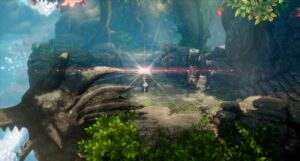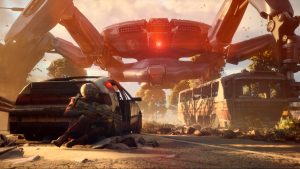
Welp, folks, we’ve got another Soulslike game on our hands with Enotria: The Last Song. This Italian themed Soulslike wears its inspirations on its sleave, but it does enough with its systems to avoid feeling too derivative. Enotria’s structure and combat is shamelessly taken from Dark Souls, but its emphasis on build variety and unique Mask Line system stands out as something original. Though Enotria may look like just another cheap Soulslike clone at first glance, its remarkable level design and unique setting help it rise above as a competent game worth checking out.
Before diving into what makes Enotria unique and interesting, let’s go over the litany of bugs that players are experiencing. Before the day-1 patch, the intro cinematic overlaid a death screen preventing players from progressing. This got partially fixed, but still occasionally shows the death screen overlay with mismatched visuals. What makes matters worse is that cutscenes are entirely unskippable, so you have to sit through that glitchy intro no matter what. At least players can skip the tutorial though.
"Bosses and enemies will occasionally stop moving and freeze in place, allowing an easy victory. Hopefully this bug gets fixed."
A common gameplay related bug that I’ve encountered freezes enemies and bosses in place, allowing for an easy unopposed victory. I’ve had enemies freeze in place at least four times during my first save game. Oh yeah, I’ve had to make multiple save slots thanks to random crashes deleting save files. I’ve had this crash file issue happen after the day-1 patch, so even if it’s a rarity, it’s still a potential game breaker for players. Besides these rather substantial bugs, Enotria runs at a consistent 60 fps, and the Graphical setting isn’t too far behind, hovering around at a respectable 40 fps.
You’d think from the sheer amount of bugs and technical issues plaguing Enotria that its graphical fidelity would suffer too, but that’s not the case. Enotria looks visually rich with its application of Unreal Engine 5 portraying a fantastical Italy. The draw distance is surprisingly good and textures on grass and castle walls impress with varied organic patterning and high resolution detail. I particularly like what they’ve done with the lighting. They nailed the atmosphere of the Mediterranean coast-inspired location of Falesia Magna; the place shimmers with salt-soaked rock edifices under a brilliant sun. You really feel the Italian atmosphere in Enotria, whether it’s in a densely compacted medieval hill town or some vibrant Tuscany-like fields.
Enotria manages to straddle the line between realism and vibrant fantasy really well with its color usage. There’s just the right amount of granular detail on clothing and wear on swords to make it feel grounded, mixed with high contrast lighting common in fantasy settings. This rich contrast is represented well with the almost Halloween-esque Monestary of Maja courtyard area. The hues of dark blue and purple contrast the bright sun-lit environments of other areas well, going to show just how diverse Enotria’s locations can be. No two areas look the same, with each of the four major zones portraying a theme and aesthetic wholly unique.
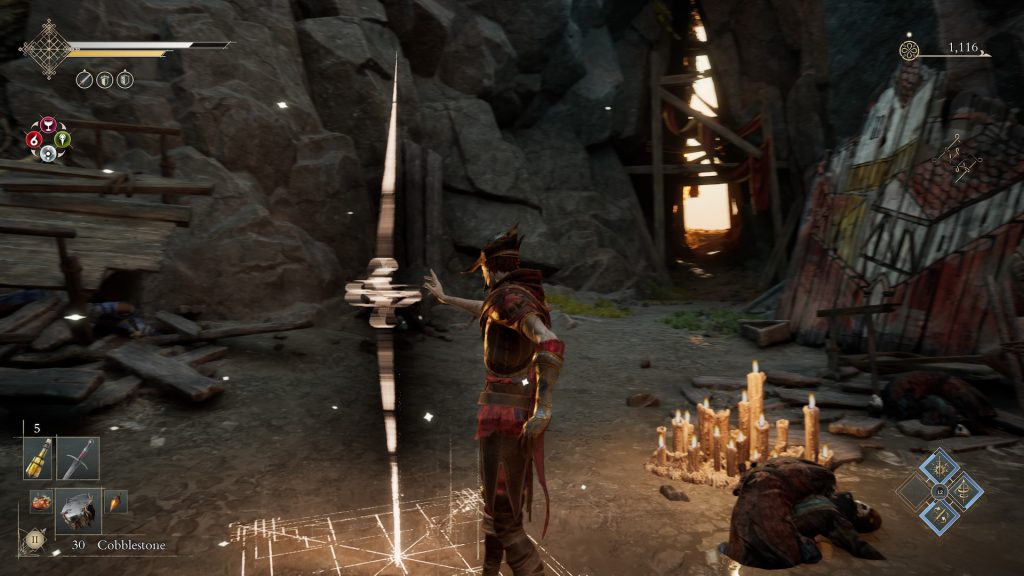
"One of the many Reality Knot checkpoints you’ll come across, allowing fast-travel access and health regeneration."
One of the main ways you’ll be going to and from each area is through the tried and tested fast-travel system. If you’ve played just about any Soulslike, Enotria’s fast travel and ‘bonfire’ system will be all-too familiar. Resting at a Reality Knot (or bonfire in Soulslike parlance) not only heals and resets your healing items and enemy encounters, but grant you the ability to fast travel between Knots. The Reality Knots in Enotria are evenly spaced apart with few instances of the boss lead-up problem some Soulslike games suffer from. I can’t be the only one relieved that I don’t have to travel through an entire town filled with angry enemy mobs just to reach the boss arena from the Knot checkpoint in this game. Along with the decent checkpointing are a fair spread of enemy mobs. I rarely felt unfairly overwhelmed by hordes of enemies like I did in Dark Souls 2, for example. Enotria’s enemy spread is similar to Dark Souls 1, allowing players the option to just run past every enemy to unlock a door or retrieve souls, or Memoria as this game’s experience and currency is called.
Memoria can be used to upgrade armor, weapons, and even your class-like Masks. Masks are what really differentiate Enotria from other games in the genre. There’s a ton of different Masks in the game, all of which confer different attributes and unique buffs. Combining Masks with Mask Lines, which are basically action abilities, allow for a wide variety of builds that you can employ. My issue with Lines is the strong emphasis on affinities in Enotria. A majority of enemies and bosses have a particular affinity, or element, that they exhibit. You will often need to take advantage of their affinity by using an affinity they’re weak to. This is done by infusing your weapon from any of your four Lines. The issue is there’s no visual indicator at-a-glance what affinity is set to which Line. You have to go in the menu and memorize what Line ability is infused with what affinity and what buffs you have equipped to infuse your weapon.
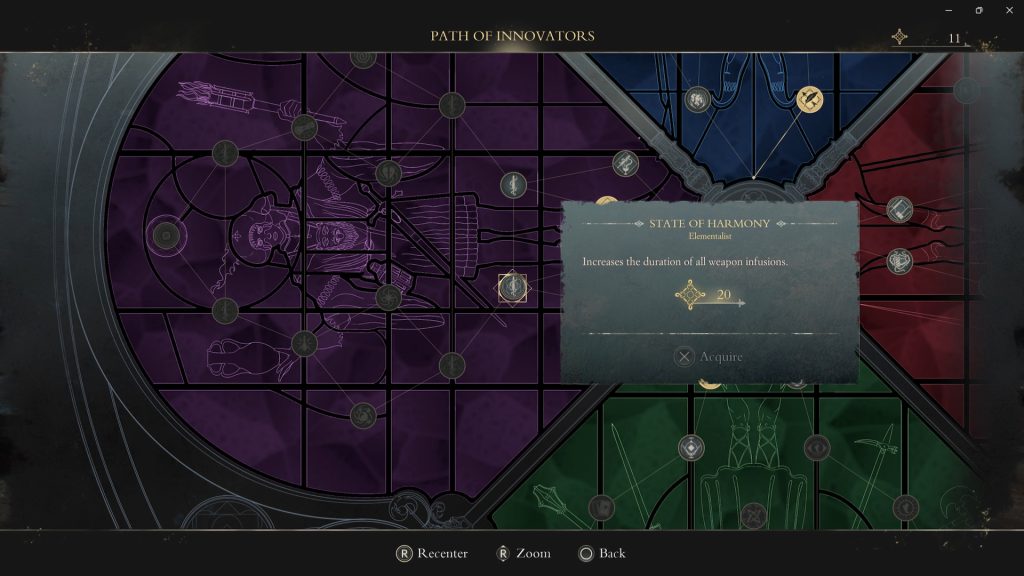
"Enotria’s skill tree covers a wide range of passive and active buffs"
The elemental rock/paper/scissors gameplay could have been awesome if it were more streamlined and easier to discern what affinity you are using. Speaking of affinities, Enotria’s skill tree is rather comprehensive with its various buffs and perks. I mostly avoided playing as an elemental warrior after realizing how much memorization I’d have to waste on the affinity system, but it’s a powerful build option for players who want to go for the battlemage playstyle. Overall, I enjoy the deep well of variety that Enotria’s Mask system allows but find the poor visual indications with affinities cumbersome, not to mention the hit-or-miss moment to moment gameplay.
Combat consists of a light attack, strong attack, and a strong emphasis on parrying. Even with the lightest of swords, your swings feel rather slow and cumbersome to pull off. Heavy attacks with greatswords take forever to connect with enemies, so my usual go-to greatsword build in games like this went out the window thanks to that. Connecting hits lacks viscerality due to lackluster feedback from the visuals and sound effects. Thankfully, a majority of enemies leave recognizable patterns and tells in their attacks, giving the player the opportunity to memorize and parry attacks appropriately, but there’s just something lacking in the viscerality department all the same.
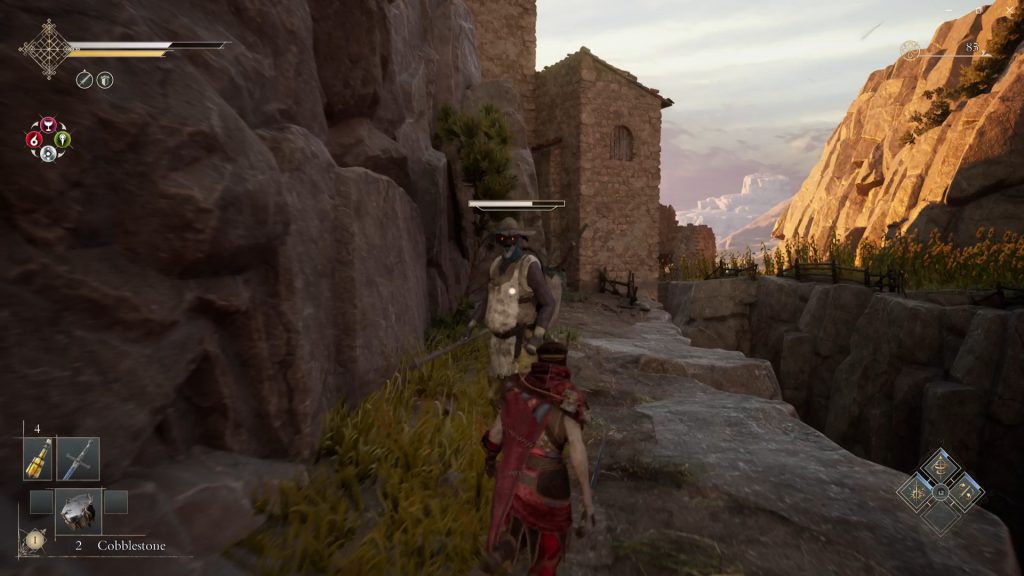
"Combat hinges on an enemy’s break bar, requiring a solid command of parry timings."
I do like the parry/break system inherent in Enotria’s combat though. You inflict a lot of damage by depleting the enemy’s break meter, after which a finishing move can be pulled off for massive damage. The easily telegraphed attacks allowed me to time perfect parries more than other games in the same genre, but some enemies and most bosses just have way too much health despite that convenience. Bosses in particular are so overtuned and unfun to fight a majority of the time because of padded health. It’s not that the bosses in Enotria are super difficult like they are in Shadow of the Erdtree; no, oftentimes, I’d memorize their patterns and learn their parry windows fairly quickly. They just take too long to fight, requiring a great deal of patience and repetitive actions to overcome. Even when I started up a second game with a strong min/max build, bosses still felt a tad too repetitive.
That said, the emphasis on parrying may still delight fans of Sekiro in particular. The dodging in this game is quick and very convenient, and the ability to switch role loadouts in the middle of combat streamlines and opens up gameplay. I just wish swinging your weapon had more swiftness and oomph to it. The running attack is particularly clunky, striking a resemblance to the undead enemies from Dark Souls 1, and that’s not a compliment.
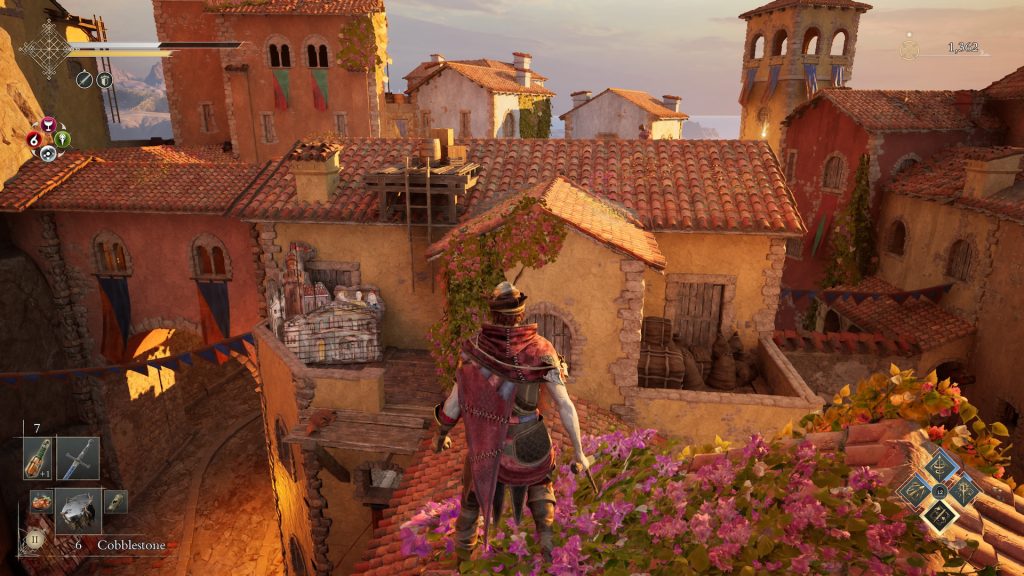
"Enotria’s winding roads and hidden pathways are intricately laid out, often looping in on itself to provide shortcuts."
Intricate level design is where Enotria truly impresses. It was deep within one of the dense Mediterranean locales when I earnestly considered giving this game an 8 out of 10 instead of my final score of 7. You’re constantly finding new shortcuts while looping in on previous areas. The sense of joy upon looping in on the other side of a locked gate rivals Dark Souls 1, a game whose inspiration is immediately made clear. But it’s not just that the Italian city streets and countryside hedge mazes are well designed from a gameplay perspective, they’re populated with various doodads and props that enrichen each environment even further. The set dressing is simply brimming with liveliness in Enotria, even if most of it can’t be interacted with. I cannot stress enough how satisfying some of the stage design is in Enotria, and it’s pretty dang consistent with its quality too.
Unfortunately, the game does a very poor job of guiding the player where to go in between these brilliant labyrinthian stages. After the first major boss of the game, you’re expected to return to the very first location of the game where a gate randomly opens the way forward. A day 1 patch added a brief cutscene showing the gate opening, but even that confused players because you encounter multiple similar-looking gates leading up to the first major boss fight. A majority of Soulslike games guide the player through NPC dialogue or cleverly placed item descriptions, and while Enotria does indeed have these things, it doesn’t use them to give the player hints of where to go. Considering how organic and dense the levels are themselves, it’s disappointing how you just warp between major zones rather than traverse there yourself. Despite excellent levels in and of themselves, Enotria exhibits poor logical flow between levels and even worse guidance of how to proceed forward.
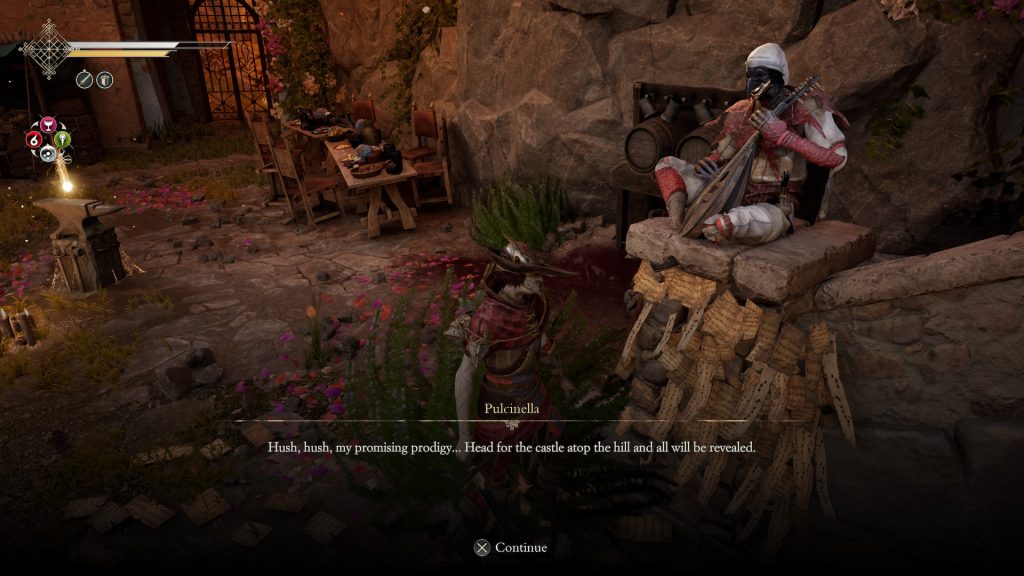
"Pulcinella acts as your tour guide throughout Enotria’s narrative. Though, he’s not the only curious character you’ll encounter."
Lastly, there’s the plot and story of Enotria. There’s not much to talk about here, but if you like the usual Fromsoft Souls method of storytelling, you’ll be at home within Enotria. The opening cinematic, when it’s not glitched, even lays out the lineup of the game’s biggest players and most noteworthy adversaries with dramatic narration. You have a recuring companion character named Pulcinella who prodes you on and gives you context to what you’re doing. Most of the deeper lore is found in Compendium entries scattered throughout the various nooks and crannies of Enotria’s dense environs. There’s even a bestiary that updates as you defeat more of a particular enemy, which goes further than most Soulslikes. But don’t expect much in the way of character development or riveting cutscenes here, this is a dyed in the wool Soulslike game without any attempt to push its storytelling further.
Despite my issues with game breaking bugs and questionable guidance in between levels, I thoroughly enjoyed my time in Enotria’s fantastical Soulslike version of Italy. The looping shortcuts and dense environments are deserving of praise with how expertly crafted they are. I simply adored exploring these Italian-laden environments and wish some of the gameplay elements shined as brightly. Combat can feel clunky at times, but isn’t a deal-breaker for me. If the team can fix the remaining bugs and clean up the at-a-glance affinity issues I had, Enotria can easily be an 8 out of 10 game, but as it currently stands, it’s a rather enjoyable, though flawed Soulslike.
This game was reviewed on the PlayStation 5.
Intricate level design that frequently loops in on itself and presents shortcuts; Wonderfully realized art style capturing the fantastical Italian setting well; Mask system gives a good amount of class options; Parrying is fun thanks to good enemy attack patterns
Substantial bugs and glitches that plague the experience; Very poor guidance in between major areas; Slow and clunky sword combat and padded boss health.











